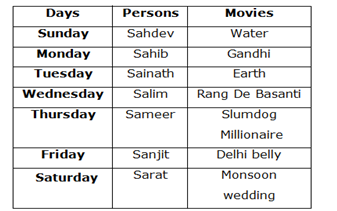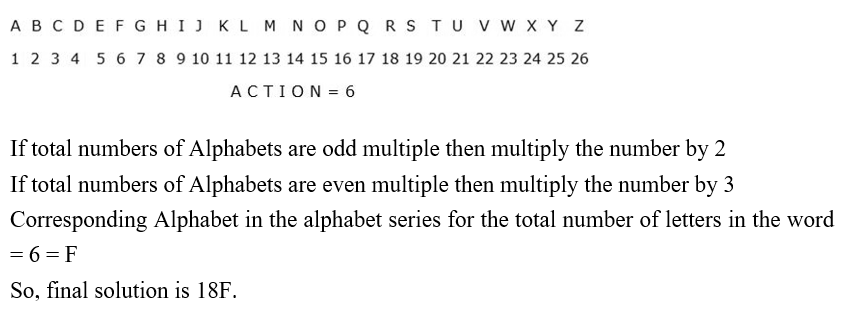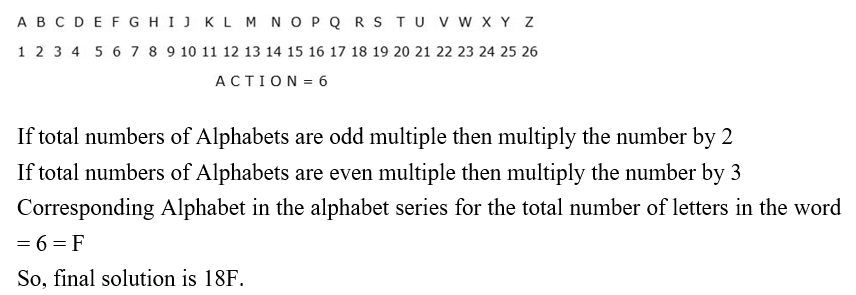Question 1:
निर्देश : निम्नलिखित जानकारी का ध्यानपूर्वक अध्ययन करें और नीचे दिए गए प्रश्नों का उत्तर दें.
Direction : Study the following information carefully and answer the questions given below.
रविवार से शनिवार वाले सप्ताह के विभिन्न दिनों में सात व्यक्ति सहदेव, साहिब, साईनाथ, सलीम, समीर, संजीत और सरत फिल्म देखने जा रहे हैं।प्रत्येक अलग-अलग फिल्म देखने गए जैसे रंग दे बसंती, स्लमडॉग मिलियनेयर, मॉनसून वेडिंग, वॉटर, गांधी, अर्थ और देली बेली लेकिन जरूरी नहीं उसी क्रम में हो । साहिब बुधवार से पहले किसी दिन गांधी फिल्म देखने जाता है। साहिब और देली बेली फिल्म जाने वाले के बीच तीन व्यक्ति फिल्म देखने गए। जो अर्थ फिल्म देखने जाता है वह व्यक्ति साहिब के तुरंत बाद फिल्म देखने गया। सरत, सलीम के बाद किसी एक दिन फिल्म देखने जाता है। समीर, देली बेली फिल्म देखने वाले व्यक्ति के तुरंत पहले फिल्म देखने जाता है। सरत और सलीम के बीच केवल दो व्यक्ति फिल्म देखने गए थे। सलीम न तो रविवार और न ही मंगलवार को फिल्म देखने जाता है। सरत और स्लमडॉग मिलियनेयर फिल्म जाने वाले व्यक्ति के बीच केवल एक व्यक्ति फिल्म देखने जाता है। शनिवार और मंगलवार को फिल्म जाने वाले व्यक्ति स्लमडॉग मिलियनेयर फिल्म नहीं देखते हैं। साहदेव वॉटर फिल्म देखने जाता है। साईनाथ शुक्रवार को फिल्म देखने नहीं जाता हैं। समीर और मॉनसून वेडिंग फिल्म देखने वाले व्यक्ति के बीच केवल एक व्यक्ति फिल्म देखने जाता है।
Seven persons Sahdev, Sahib, Sainath, Salim, Sameer, Sanjit, and Sarat are going to movies on different days of a week starting from Sunday to Saturday. Each went to different movies viz. Rang de Basanti, Slumdog Millionaire, Monsoon Wedding, Water, Gandhi, Earth and Delhi Belly but not necessarily in the same order. Sahib goes to Gandhi movie on one of the days before Wednesday. Three persons went to the movies between Sahib and the one who goes to the movie Delhi Belly. The person who goes to Earth movie went immediately after Sahib. Sarat goes to the movie in one of the days after Salim. Sameer goes to the movie immediately before the person who goes to Delhi Belly movie. Only two people went to movies between Sarat and Salim. Salim goes to the movie neither on Sunday nor Tuesday. Only one person goes to the movie between Sarat and the person who goes to Slumdog Millionaire movie. The people who goes to the movie on Saturday and Tuesday, does not watch Slumdog Millionaire movie. Sahdev goes to the water movie. Sainath does not go to the movie on Friday. Only one person goes to the movie between Sameer and the person, who goes to Monsoon Wedding movie.
If Sunday is related to Earth movie and Wednesday is related to Delhi Belly movie in a certain way then, Monday is related to which of the following movie?
यदि एक निश्चित तरीके से रविवार अर्थ फिल्म से संबंधित है और बुधवार देली बेली फिल्म से संबंधित है, तो सोमवार निम्नलिखित किस फिल्म से संबंधित है?
Question 2:
निर्देश : निम्नलिखित जानकारी का ध्यानपूर्वक अध्ययन करें और नीचे दिए गए प्रश्नों का उत्तर दें.
एक निश्चित कोड में,
“Proposal raises several troubling” को “24H 18I 18F 14G” के रूप में कोडित किया गया है
“Mandatory open offer requirement” को “22K 10E 12D 18I” के रूप में कोडित किया गया है
“Prompt corrective action framework” को “18F 18I 30J 18F” के रूप में कोडित किया गया है
“Banking regulator should ignore risks” को “10E 18F 14G 18I 18F” के रूप में कोडित किया गया है
Direction: Study the following information carefully and answer the questions given below.
In a certain code,
“Proposal raises several troubling” is coded as “24H 18I 18F 14G”
“Mandatory open offer requirement” is coded as “22K 10E 12D 18I”
“Prompt corrective action framework” is coded as “18F 18I 30J 18F”
“Banking regulator should ignore risks” is coded as “10E 18F 14G 18I 18F”
What is the code for “Befuddle” in this code language?
इस कोड भाषा में “Befuddle” के लिए कोड क्या है?
Question 3:
निर्देश : निम्नलिखित जानकारी का ध्यानपूर्वक अध्ययन करें और नीचे दिए गए प्रश्नों का उत्तर दें.
एक निश्चित कोड में,
“Proposal raises several troubling” को “24H 18I 18F 14G” के रूप में कोडित किया गया है
“Mandatory open offer requirement” को “22K 10E 12D 18I” के रूप में कोडित किया गया है
“Prompt corrective action framework” को “18F 18I 30J 18F” के रूप में कोडित किया गया है
“Banking regulator should ignore risks” को “10E 18F 14G 18I 18F” के रूप में कोडित किया गया है
Direction: Study the following information carefully and answer the questions given below.
In a certain code,
“Proposal raises several troubling” is coded as “24H 18I 18F 14G”
“Mandatory open offer requirement” is coded as “22K 10E 12D 18I”
“Prompt corrective action framework” is coded as “18F 18I 30J 18F”
“Banking regulator should ignore risks” is coded as “10E 18F 14G 18I 18F”
What is the code for “Renegotiate” in this code language?
इस कोड भाषा में “Renegotiate” के लिए कोड क्या है?
Question 4:
निर्देश : निम्नलिखित जानकारी का ध्यानपूर्वक अध्ययन करें और नीचे दिए गए प्रश्नों का उत्तर दें.
एक निश्चित कोड में,
“Proposal raises several troubling” को “24H 18I 18F 14G” के रूप में कोडित किया गया है
“Mandatory open offer requirement” को “22K 10E 12D 18I” के रूप में कोडित किया गया है
“Prompt corrective action framework” को “18F 18I 30J 18F” के रूप में कोडित किया गया है
“Banking regulator should ignore risks” को “10E 18F 14G 18I 18F” के रूप में कोडित किया गया है
Direction: Study the following information carefully and answer the questions given below.
In a certain code,
“Proposal raises several troubling” is coded as “24H 18I 18F 14G”
“Mandatory open offer requirement” is coded as “22K 10E 12D 18I”
“Prompt corrective action framework” is coded as “18F 18I 30J 18F”
“Banking regulator should ignore risks” is coded as “10E 18F 14G 18I 18F”
Which of the following word matches the code “14G” from the above coded language?
निम्न में से कौन सा शब्द उपरोक्त कोडित भाषा से कोड “14G” से मेल खाता है?
Question 5:
निर्देश : निम्नलिखित जानकारी का ध्यानपूर्वक अध्ययन करें और नीचे दिए गए प्रश्नों का उत्तर दें.
एक निश्चित कोड में,
“Proposal raises several troubling” को “24H 18I 18F 14G” के रूप में कोडित किया गया है
“Mandatory open offer requirement” को “22K 10E 12D 18I” के रूप में कोडित किया गया है
“Prompt corrective action framework” को “18F 18I 30J 18F” के रूप में कोडित किया गया है
“Banking regulator should ignore risks” को “10E 18F 14G 18I 18F” के रूप में कोडित किया गया है
Direction: Study the following information carefully and answer the questions given below.
In a certain code,
“Proposal raises several troubling” is coded as “24H 18I 18F 14G”
“Mandatory open offer requirement” is coded as “22K 10E 12D 18I”
“Prompt corrective action framework” is coded as “18F 18I 30J 18F”
“Banking regulator should ignore risks” is coded as “10E 18F 14G 18I 18F”
Which of the following word matches the code “30J” from the above coded language?
निम्न में से कौन सा शब्द उपरोक्त कोडित भाषा में कोड “30J” से मेल खाता है?
Question 6:
निर्देश : निम्नलिखित जानकारी का ध्यानपूर्वक अध्ययन करें और नीचे दिए गए प्रश्नों का उत्तर दें.
एक निश्चित कोड में,
“Proposal raises several troubling” को “24H 18I 18F 14G” के रूप में कोडित किया गया है
“Mandatory open offer requirement” को “22K 10E 12D 18I” के रूप में कोडित किया गया है
“Prompt corrective action framework” को “18F 18I 30J 18F” के रूप में कोडित किया गया है
“Banking regulator should ignore risks” को “10E 18F 14G 18I 18F” के रूप में कोडित किया गया है
Direction: Study the following information carefully and answer the questions given below.
In a certain code,
“Proposal raises several troubling” is coded as “24H 18I 18F 14G”
“Mandatory open offer requirement” is coded as “22K 10E 12D 18I”
“Prompt corrective action framework” is coded as “18F 18I 30J 18F”
“Banking regulator should ignore risks” is coded as “10E 18F 14G 18I 18F”
What is the code for “Aggravation Pleasure” in this code language?
इस कोड भाषा में “Aggravation Pleasure” के लिए कोड क्या है?
Question 7:
The position of how many alphabets will remain unchanged if each of the alphabets in the word “BELLIGERENT” is arranged in alphabetical order from right to left?
यदि “BELLIGERENT” शब्द में प्रत्येक अक्षर को वर्णमाला क्रम में दाएं से बाएं व्यवस्थित किया गया है, तो कितने वर्णमाला की स्थिति अपरिवर्तित रहेगी?
Question 8:
If “1” is subtracted from each odd digit and “2” is added from each even digit in the number 12345679, then how many digits appear twice in the new number thus formed?
यदि 12345679 संख्या में प्रत्येक विषम अंक से "1" घटाया जाता है और प्रत्येक सम अंक में "2" जोड़ा जाता है, तो इस प्रकार बने नए नंबर में कितने अंक दो बार दिखाई देते हैं?
Question 9:
निर्देश : निम्नलिखित प्रश्नों में प्रश्नवाचक चिह्न (?) के स्थान पर क्या होना चाहिए?
Direction : what should come in place of the question mark (?) in the following questions?
494 × 494 + 204 × 204 + 2 × 494 × 204 is
Question 10:
निर्देश : निम्नलिखित प्रश्नों में प्रश्नवाचक चिह्न (?) के स्थान पर क्या होना चाहिए?
Direction : what should come in place of the question mark (?) in the following questions?
484 × 64 × 18 / (324 × 16 × 81) = ?








